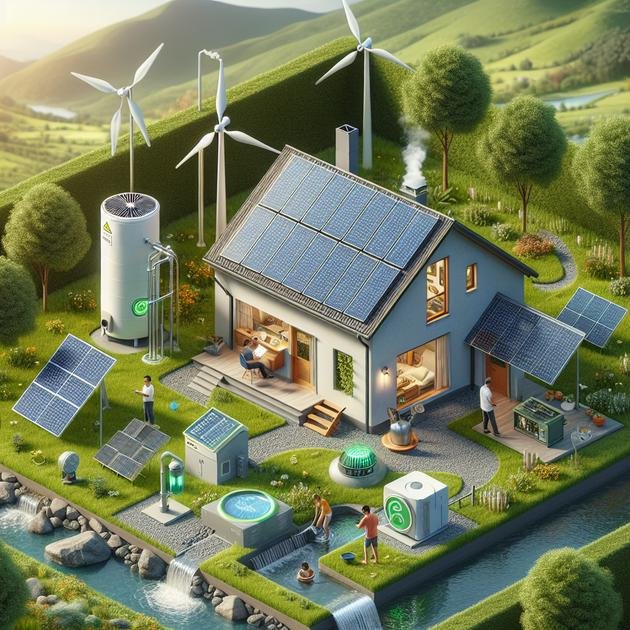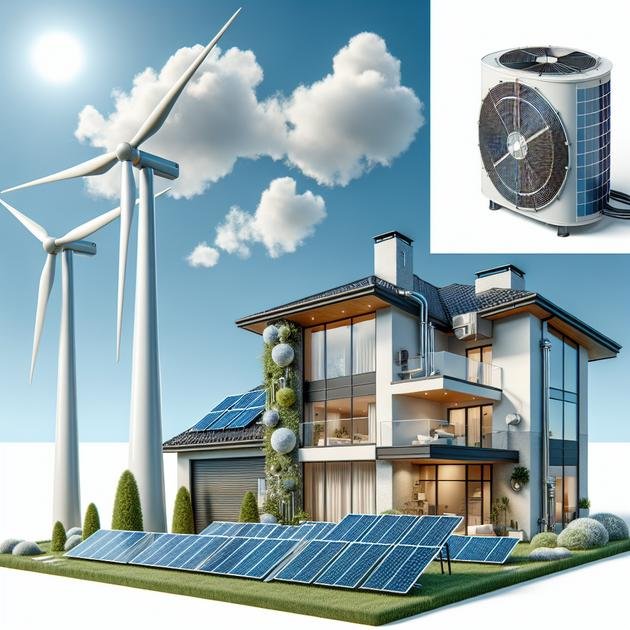Renewable energy basics involve using natural, replenishable sources like solar, wind, and geothermal to power homes efficiently while reducing carbon emissions and energy costs.
Renewable energy basics can feel overwhelming at first, but getting to know the essentials helps you see real possibilities for your home. Ever wondered how clean energy can change your daily life? Let’s break it down in a simple way you can relate to.
what is renewable energy and why it matters
Renewable energy comes from natural sources that are constantly replenished, such as sunlight, wind, rain, tides, and geothermal heat. Unlike fossil fuels, these sources don’t run out and produce little to no pollution. Understanding renewable energy basics is important because it helps homeowners reduce their environmental impact and potentially save on energy costs.
Why renewable energy matters for homeowners
Using renewable energy at home means relying less on traditional power plants that burn coal or oil, which release harmful gases. This switch supports cleaner air and a healthier planet. Many homeowners also find that renewable systems increase their property value and provide protection against rising electricity prices.
Renewable energy is also crucial in fighting climate change since it reduces greenhouse gas emissions. By adopting renewable sources, homeowners contribute to a sustainable future. This shift is becoming easier with advancing technology and more affordable options.
common types of renewable energy for homes
Homes can use several common types of renewable energy that offer clean, sustainable power. The most popular option is solar energy, which uses panels to convert sunlight into electricity. Solar systems are versatile, working well in many climates and requiring little maintenance.
Wind energy is another option. Small wind turbines can be installed on properties where there is enough steady wind. These turbines generate electricity that can power your home or reduce your overall energy bills.
Geothermal energy taps into the Earth’s natural heat to provide heating and cooling. This system uses a ground-source heat pump to move heat between the ground and your home, offering efficient temperature control year-round.
Biomass energy uses organic materials like wood pellets or plant waste to create heat or electricity. It’s a renewable way to keep your home warm during colder months.
Each type has benefits based on location, cost, and energy needs. Homeowners often combine two or more of these sources to create a reliable and eco-friendly energy system tailored to their situation.
how solar panels work and what to expect

Solar panels are devices that convert sunlight into electricity through a process called the photovoltaic effect. They are made up of many solar cells, usually made from silicon, that absorb sunlight and generate direct current (DC) electricity. This DC electricity then passes through an inverter, which converts it into alternating current (AC) that your home can use.
What to expect from solar panels
Efficiency depends on factors like panel quality, sunlight availability, and shading. Most panels produce energy during daylight hours, with peak performance under direct sunlight.
Installing solar panels can significantly reduce your electricity bills by generating some or all of your power needs. You might even be able to sell excess energy back to the grid in some areas, earning credits or payments.
Maintenance is generally low, requiring occasional cleaning and periodic inspections to ensure optimal performance. Modern solar panels are built to last 25 years or more.
It’s important to have a professional assess your home’s solar potential and recommend a system size that fits your energy needs and budget.
benefits of using renewable energy at home
Using renewable energy at home brings many benefits that go beyond just saving money. One key advantage is reducing your carbon footprint, which means your home releases less harmful greenhouse gases. This helps protect the environment and fight climate change.
Renewable energy can also increase your home’s value. Many buyers prefer homes with solar panels or other green features because they lower energy costs and support a sustainable lifestyle.
Energy independence is another benefit. By generating your own power, you rely less on the grid and are protected from rising electricity prices and power outages.
Some renewable systems, like solar panels, require little maintenance and last for decades, offering long-term savings and peace of mind.
Many governments and utilities offer rebates, tax credits, or other financial incentives for installing renewable energy systems, making it more affordable to switch.
cost considerations and financial incentives
When thinking about renewable energy for your home, understanding cost considerations is essential. Initial installation costs for systems like solar panels or wind turbines can be significant. However, these upfront expenses are often balanced by long-term savings on energy bills.
Factors that affect cost
System size, type, and your location all affect the price. More powerful systems or those with battery storage tend to cost more. Local climate impacts how much energy your system can produce, influencing the overall value.
Financial incentives and rebates
Many governments and utilities offer incentives such as tax credits, rebates, or grants to help lower installation costs. For example, the federal solar tax credit in the U.S. allows homeowners to deduct a percentage of their system cost from their taxes.
Some areas also have net metering programs, where you can sell excess electricity back to the grid, generating credits or extra income.
It’s wise to research all available incentives and consult with a professional to maximize your savings and choose the best system for your budget.
challenges in adopting renewable energy

Adopting renewable energy at home comes with some challenges that homeowners should know. One common issue is the initial cost, which can be high for solar panels, wind turbines, or geothermal systems. Even with incentives, the upfront investment might feel overwhelming.
Technical barriers
Not all homes are suitable for every renewable system. Location, roof size, and shading can limit solar panel effectiveness. Wind turbines require steady wind, which is not available everywhere.
Installation and maintenance
Installing renewable systems may require permits and professional assessment. Maintenance is usually low but some systems, like biomass or wind turbines, need occasional upkeep.
Energy storage is another challenge. Renewable sources like solar and wind produce energy intermittently, so storing or managing power to use it when needed can be tricky and costly.
Finally, some homeowners face regulatory hurdles or local restrictions that limit renewable energy installations. Understanding these rules before committing is important to avoid surprises.
tips for choosing the right renewable energy system
Choosing the right renewable energy system for your home involves careful consideration of several factors. Start by evaluating your energy needs. Look at your past electricity bills to understand how much power you use daily and seasonally.
Assess your location and property
Some systems work better in certain climates. For instance, solar panels need ample sunlight, while wind turbines require steady, strong winds. Check if your property has suitable roof space or land for installation.
Consider your budget and incentives
Initial costs vary widely. Research available financial incentives like tax credits and rebates that can make certain options more affordable. Factor in long-term savings on energy bills as well.
Research system reliability and maintenance
Look for systems known for durability and low maintenance. For example, solar panels typically need minimal upkeep, while biomass systems may require more attention.
Consulting with a renewable energy professional can help tailor the best choice for your unique situation. They can perform energy audits and suggest the most efficient and cost-effective systems.
Remember, combining systems—like solar with battery storage—may provide more consistent energy and greater independence from the grid.
future trends in home renewable energy
Home renewable energy is evolving with exciting new trends that make green power more accessible and efficient. One growing trend is advanced energy storage, such as improved battery systems that store solar energy for use at night or during outages.
Smart home integration
Renewable energy systems are increasingly connected to smart home technology. This allows homeowners to monitor and control energy use in real time, optimizing savings and efficiency.
Hybrid systems
More homes are combining multiple renewable sources, like solar and wind, with energy storage to improve reliability and reduce dependence on the grid.
Community solar programs are also on the rise, letting people invest in shared solar projects without installing panels on their own roofs. This expands access to renewable energy.
The cost of renewable technologies continues to drop, and innovations in solar panel materials and wind turbine designs promise more power from smaller setups.
Looking Ahead with Renewable Energy
Renewable energy offers homeowners a way to save money, protect the environment, and gain energy independence. While there are challenges, advances in technology make it easier than ever to adopt clean power at home.
Understanding your energy needs and exploring new trends like smart integration and energy storage can help you make smart choices. Whether through solar, wind, or other systems, renewable energy is becoming a valuable part of modern homes.
By taking steps now, you contribute to a healthier planet and a more sustainable future for generations to come.





